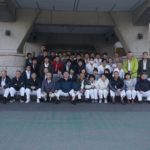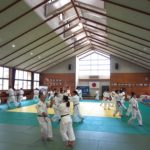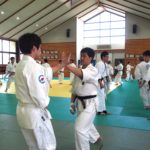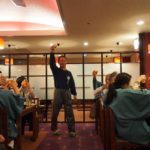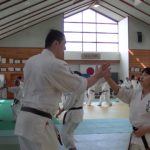Published March 13, 2017 13:04
Shodokan Spring Camp Report
Osaka Station.
It was 9:20 am Saturday, March 4th, 2017 when about twenty of us gathered in Osaka Station – most of us were early while one of us was late. At around 9:35, Sakai sensei counted the heads of those present and led us across the cement floor to the JR entrance – the clacking of suitcase-casters echoed off the walls of the station. There he explained that we were a group and handed, to a black-uniformed JR man, a wad of train tickets. The JR man counted each one and then nodded his permission for us to enter. Shihan followed by Nariyama Tetsuya and myself, led everyone up the escalator to the platform. We had a few minutes to wait. It was cold, and as we stood there in the chilly weather, Teranishi-sensei glanced at Erin Johnson and asked me, “Isn’t she cold?” I looked over at Erin and saw that she was wearing, what looked like, mid-spring clothing. I turned back to Teranishi-sensei and replied, “She’s from Alaska. This weather is probably warm for her.” Hearing, ‘Alaska‘ mentioned, Erin stepped forward to listen to our conversation and as she did she heard Teranishi-sensei state, “I never want to marry anyone from Alaska.” Erin’s mouth dropped in mock surprise while Teranishi-sensei laughed loudly. Shihan, who had been listening to the conversation, also had a smile on his face.
The Departure and Arrival.
The announcement over the PA system told us and hundreds of other travelers that the train would arrive in less than a minute. Sure enough, the distinct blast of a train horn echoed around the station. The name plastered in large blue letters across the front and side of the thirteen-car train was ‘Thunderbird.’ – no we weren’t about to board a rocket from a 1960’s TV show. We all clambered onto the train and found seats in an unreserved car, quite close to one another. The Thunderbird departed exactly on time, and we all sat back and mentally prepared ourselves for the two-hour trip to Fukui. Sakai-sensei stood and explained to the conductor, making his way along the aisle, that we were all together. This different JR man nodded and stamped the tickets Sakai-sensei passed him. The next two hours, ticked by relatively quickly as most of us slept. When the train pulled into Fukui Station it was 11:30 am. We descended the steps to the first floor of the station building and met, by chance, some of the university students from Osaka who were also joining the camp. Near the ticket wicket, the Tokyo contingency stood quietly waiting.Once again, we lined up in front of another JR station counter. Sakai-sensei counted heads and pleased no one was suffering from motion sickness, dead or still on the train; he led us all out of the station to two mini-buses parked nearby. The drivers stood by the door of each vehicle. After a few minutes of bowing and greeting the drivers with “Onegaishimasu,” – a useful Japanese word that I think means “Do me a favor, will ya?” we all loaded ourselves aboard and were soon heading for our hotel.
The Hotel.
It took about 45 minutes to reach the hotel, and after a few moments of listening to Sakai-sensei explain the rest of the day’s schedule, we moved into, what appeared to be, the hotel’s one and only restaurant for lunch. The meal was waiting for us – Sakai-sensei had planned ahead of time, good man! After a hastily eaten meal, we all stood around in the lobby and told who was sharing with who. There were five in each room. We then received our keys and were ordered to be back in the lobby in our dogis by 13:00. Everyone quickly headed upstairs to the third and fifth floors in search of their one-night lodgings. The rooms were Japanese style and spacious. Each had a large bathroom with a huge bathtub which looked as if it would take a week fill. It turned out no one used their bathroom because of the open-all-day onsen on the hotel’s 2nd floor. Rooms also had a western style toilet positioned to the left of the door. When I noticed this, I thought immediately of Honbu member, Rob Hori – why? I don’t know. In a large Japanese-style closet five futons were stacked high ready to be spread out on the tatami floor when the time came for sleep. At 13:00 we were all back in the lobby dressed in dogis under thick jackets – even Erin was wrapped up. With everyone accounted for, Shihan gave the order, and within minutes, we were back on the mini-buses heading to the Sakai Budokan.
The Dojo.
The commute to the dojo took around forty to forty-five minutes. As the buses bounced their way along the narrow roads, the scenery wasn’t spectacular; just open fields and rice paddies and from time-to-time a factory. In the bus I was on, passengers either snoozed or chatted quietly. Joe Adams and Erin Johnston were talking, and I heard Joe, at one point, ask whether the question Erin was about to ask him, needed an answer or could she figure it out for herself. I listened to their banter in silent amusement. Finally, we arrived at the Sakai Budokan. We all piled out of the buses and waited. “Why are we waiting outside?” Erin asked Joe. “Why do you think we’re waiting?” Joe responded. “I don’t know,” came Erin’s reply. “Well, could it be that the door is locked, and Sakai-sensei has gone to get the key?” asked Joe. It was a rhetorical question and thick with sarcasm. After about five minutes, sure enough, Sakai-sensei came walking along the road waving a key. With the doors opened, we all removed our footwear and stepped into a large dojo divided into two areas – one for Judo with mats laid out and the other a polished wooden floor for Kendo. I should also add here, that the place was cold, very cold. Nevertheless, people removed their jackets and socks and began the task of unbolting part of the steel frame that held the Judo mats to extend the matted area. This job was followed by a slew of us carrying extra yellow and green mats from the supply room and adding them to the Judo competition area. Once this chore was complete, the first practice of the spring camp got underway with Sakai-sensei taking the warm-up exercises.
The First Day Practice.
With the warm-up completed, we started practicing the basics (ki-hon). Shihan explained the purpose of each practice. Needless to say, there was a great deal of sitting in seiza listening and watching Shihan’s examples of how to do it right. Shihan explained the history of Unsoko and well as tegatana go doza. During his lecture, we learned about Tomiki Shihan’s Siberian experience toward the end of World War Two. I thought the reference to Siberia was rather fitting considering most of us were freezing and sitting in seiza, wasn’t warming us up. For more than an hour we listened, watched and practiced. In the last hour, all university student dan grades were told to make a line on one side of the mat. These young black belts were ukes for the rest of us to practice. For the next twenty minutes, we threw, pushed, pulled and locked our university student uke. It was during this practice that I felt the warmth return to my toes. Following this exercise, Shihan ordered everyone to line up in seiza. We bowed to Shomen and then to Shihan. With the first practice of the camp over, it was now time for the group dojo picture. Morikawa-sensei and NariyamaTetsuya-sensei set up cameras on tripods while Erin Johnston stood behind holding her camera. Erin, however, was soon called to join the group photo. The cameras clicked, and everyone sat or crouched with a smile on his or her face. When Nariyama Tetsuya-sensei hadn’t set his camera’s timer correctly, Teranishi-sensei complained about sitting so long in seiza, “Hurry up!,” he barked, “My legs are killing me!” The next chore for the day was to restore the dojo to how it was when we arrived; this meant picking up the heavy and thick extra mats and lugging them back to the supply room. While many of us staggered across the dojo with a yellow or green hefty mat on our back, others reconnected the frame for the Judo area. Finally, about thirty minutes after practice ended, we all climbed back on board the mini-buses for the trip back to the hotel – a bath, dinner, and a party waited.
The Party.
It started at 18:00 with a toast from Yamagata-sensei. With the clink of more than forty glasses and a mighty “Kampai,” the festivities got underway. The meal was Japanese – nabe as well as an assortment of other dishes. Sakai-sensei made the announcement we could order as much as we wanted, for the next 90 minutes, from the drink menu on each table. Well, I don’t have to tell you, that that is what everyone did. Pitchers of beer, ceramic flasks of hot sake, large glasses of red or white wine, and more; you name it, someone drank it. By the time this first party ended, at 20:00, most people were more than just a little tipsy. As is always the case, there was the inevitable second party and possibly a third in some designated room on the third floor.
When I arrived, two Japanese university student guys were in the midst of a drunken game. This game – apparently popular with young male Aikidoka – consisted of two men stripped to their underwear wrestling each other trying to remove the other’s underpants. When Erin Johnston arrived, the game was halted briefly while the two guys discussed whether or not to continue because now there was a lady, a foreign lady at that, in the room. Shoulders shrugged, and both underpants-only-clad guys decided to continue their underpants battle. This game went on for around half an hour with bare asses galore. Fortunately, the “wrestlers” were able to keep their privates hidden from view when one of them lost a match. No full frontals were witnessed, thank God. As the party wore on, the wrestling ended and then came the talking – the in-depth discussions and confessions. I spoke for a long time with Omori-sensei and Yamagata-sensei. Joe and I discussed his recent knee injury and so on. I stopped drinking at a reasonable hour as the last thing I wanted to feel in the morning was a wicked hangover. It is not wise to practice Aikido with a severe headache; a churning stomach, and a taste in your mouth like the bottom of a bird cage. At the relatively early time of 1:00 am, I left the party and by 1:30 am was sleeping on a soft futon.
The Second Day and Final Practices.
Everyone, to my surprise, was up early the following morning. I didn’t notice anyone with a severe hangover although I was sure some people weren’t feeling 100 %. Breakfast was served between 7:00 – 7:30 am. Miso soup, fish, and rice – Japanese style. I asked for coffee but, alas there was none; this is something I will never understand. For me, coffee is a staple of any breakfast – Japanese or not. I left the restaurant and found a vending machine selling cold canned coffee – better than nothing, I guess. By 7:45 am, we were all gathered in front of the hotel dressed in dogis and again, in warm jackets. Everyone had his or her overnight bag as we were not going to be returning to the hotel. Once everyone was seated back on the mini-buses we were on our way back to the dojo. Forty minutes later we pulled up in front of the locked Budo center. Sakai-sensei produced a key, and soon we were again carting heavy mats from the supply room and extending the matted area. Everyone lined up in seiza and bowed to Shomen and Shihan. Then, Yamagata-sensei stood and announced the August 18th – 20th, 2017 World Aikido Championships which will be held in London. He explained that SAF was a founding member of the WSAF (World Sports Aikido Federation) and that this next London championship was the first in, what he hoped, will be a successful event. Next to stand and face us was Nakagawa-sensei. He announced that this year is Shodokan’s 50th Anniversary. Yes, folks, 2017 marks fifty years of Shodokan Honbu. Nakagawa-sensei went on to explain that there will be a celebration of this milestone at the Osaka Municipal Gymnasium in October. It is hoped Aikidoka from around Japan and, indeed, the rest of the world, attend the festivities. Both teachers sat back down, and Shihan ordered everyone to stand and make, about ten lines of six people. Kawamura-kun led everyone in the warm-up.
The training theme today, was Goshin no kata. Omori-sensei demonstrated suwari waza after which Shihan explained the details many people forget when performing this waza. Sakai-sensei was his uke. Over the course of the morning, we practiced the different segments of Goshin no kata with Shihan giving explanations before and after each practice. Needless to say, there was a great deal of sitting, watching and learning. At around 12:30 we stopped training for lunch. Boxed-lunches had been delivered for all. Myself, Joe, Erin; Alex and a few others chose to eat outside as the weather had turned sunny and quite warm. While sitting and lapping up the warmness, Imura Satomi-san came up to me, Joe and Erin and asked us to make a video message for Fumika Yamazaki who was celebrating her wedding on the 31st of the month. My message was short but, I thought slightly humorous – “Congratulations on your marriage and remember, that one good turn gets all the blankets.” Joe Adams’ reaction to my wit was, “Samoi” (which means ‘cold’ but is also a way of telling someone their joke is bad, very bad.) Oh well, what does Joe know about jokes, anyway? Afternoon training kicked off with everyone doing hontai no tsukuri. Shihan has a plan for everyone to perform this practice during the October 50th Anniversary of Shodokan. For about thirty minutes we practiced and not once were we asked to sit and listen to a lecture.
Next, everyone was divided into two groups – university students and general members. Sakai-sensei headed the university student group as they practiced jodan and gedan tsukuris. Omori-sensei led the general members in ju-waza. Each of us found a partner and formulated our own combination of different techniques.We practiced for about 15 minutes making sure whatever combination we came up with would be remembered. Nakagawa-sensei, Teranishi-sensei, Omori-sensei; Morikawa- sensei and Yamagata-sensei, wandered around offering advice and suggestions. Finally, with each pair ready, we all performed ju-waza as though we were competing in a competition. It was fun, and the ukemi certainly warmed me up – the dojo was still a freezing. When ju-waza finished, Sakai-sensei led the university students as they demonstrated jodan and gedan tsukuri. At about 14:00, the last activity on 2017’s Spring Training Camp agenda was Omori-sensei’s coaching seminar – Shihan and other high-level teachers left the dojo to change. Omori-sensei when over the rules and answered a slew of questions, mainly from university students who wanted to know whether randori combinations they had come up with were proper techniques or not. Omori-sensei, also mentioned that a player’s attitude was also to be kept in check during a competition – rolling the eyes if a referee makes a call that a player doesn’t like, is a no-no, as too, is using intimidation techniques on an opponent before a shiai. Omori-sensei’s seminar or meeting ended at 15:00 with light randori for judges and referees to practice their calls.
After what seemed like a very long bus ride, we were back at the station and preparing to board the Thunderbird bound for Osaka. I arrived home at about 20:00 and relaxed with a couple of cans of beer and some yakitori.
Conclusion.
I think the camp was successful in that we did learn a lot from Shihan and other teachers. Whether, however, I and others can retain this newfound knowledge, remains to be seen. The only criticisms I have were, 1) the weather, it was cold – could we have spring train in spring next time? And 2) the hotel should have a choice of a Western style or Japanese style breakfast – somehow after a night of heavy drinking, miso soup, fish, and rice, isn’t appetizing. What is needed, after a night of raucous disorder, is bacon, eggs, toast and gallons of coffee – hot coffee.
